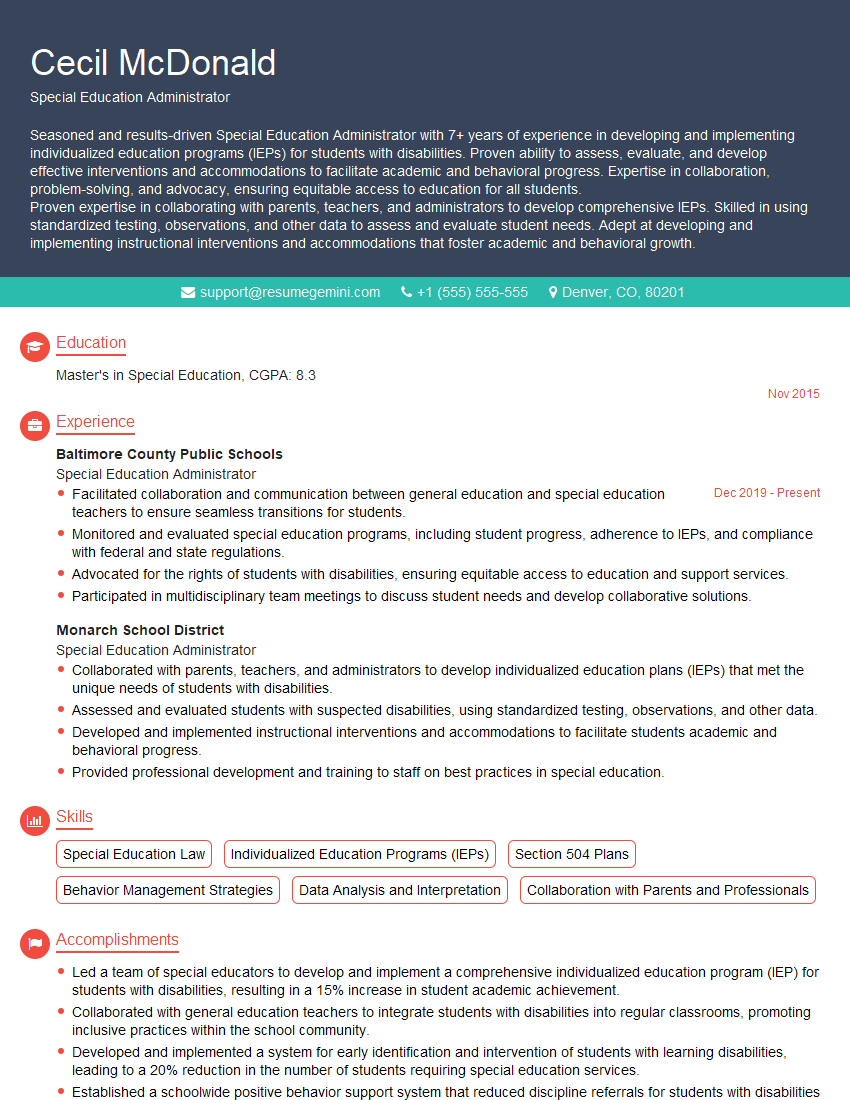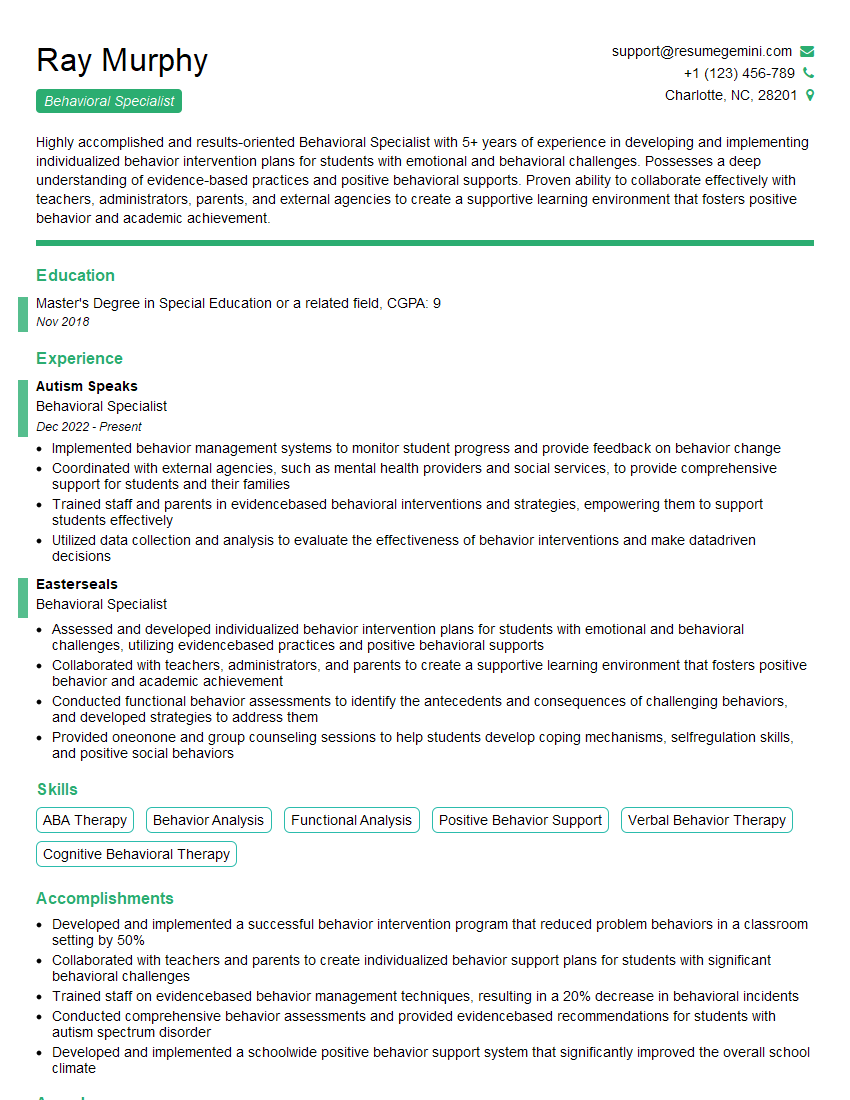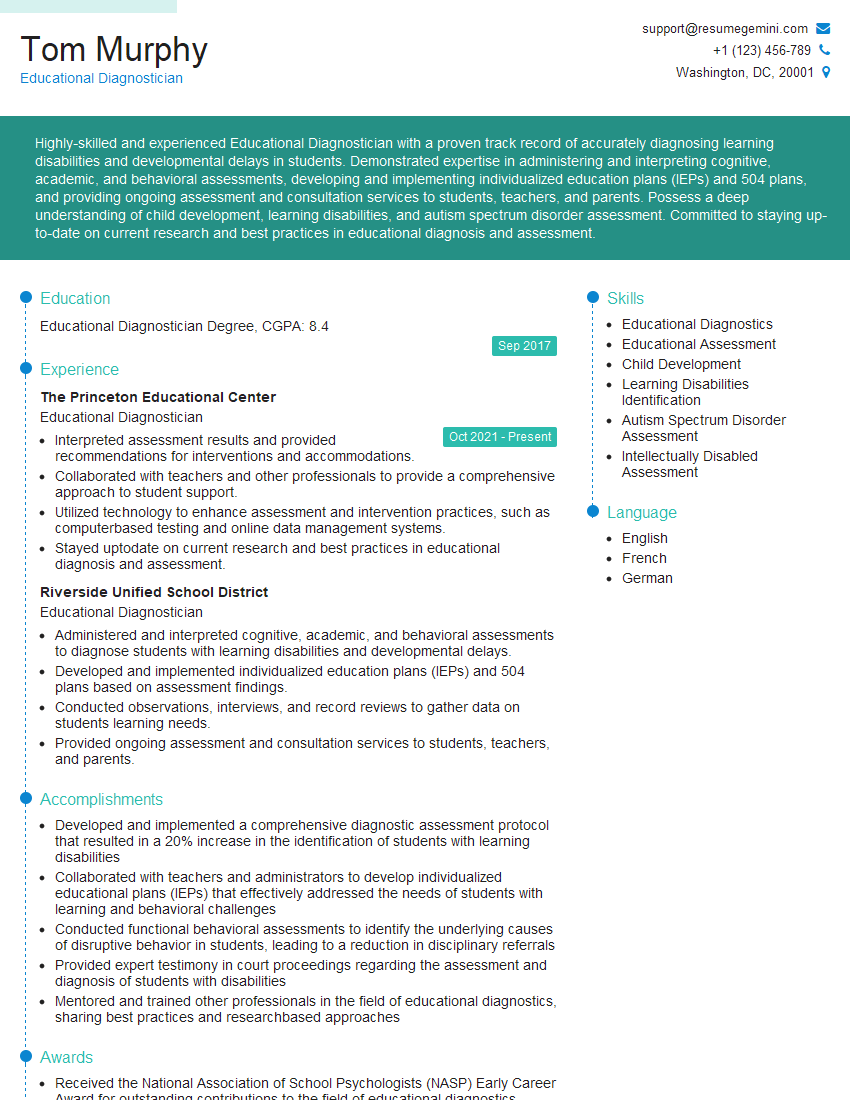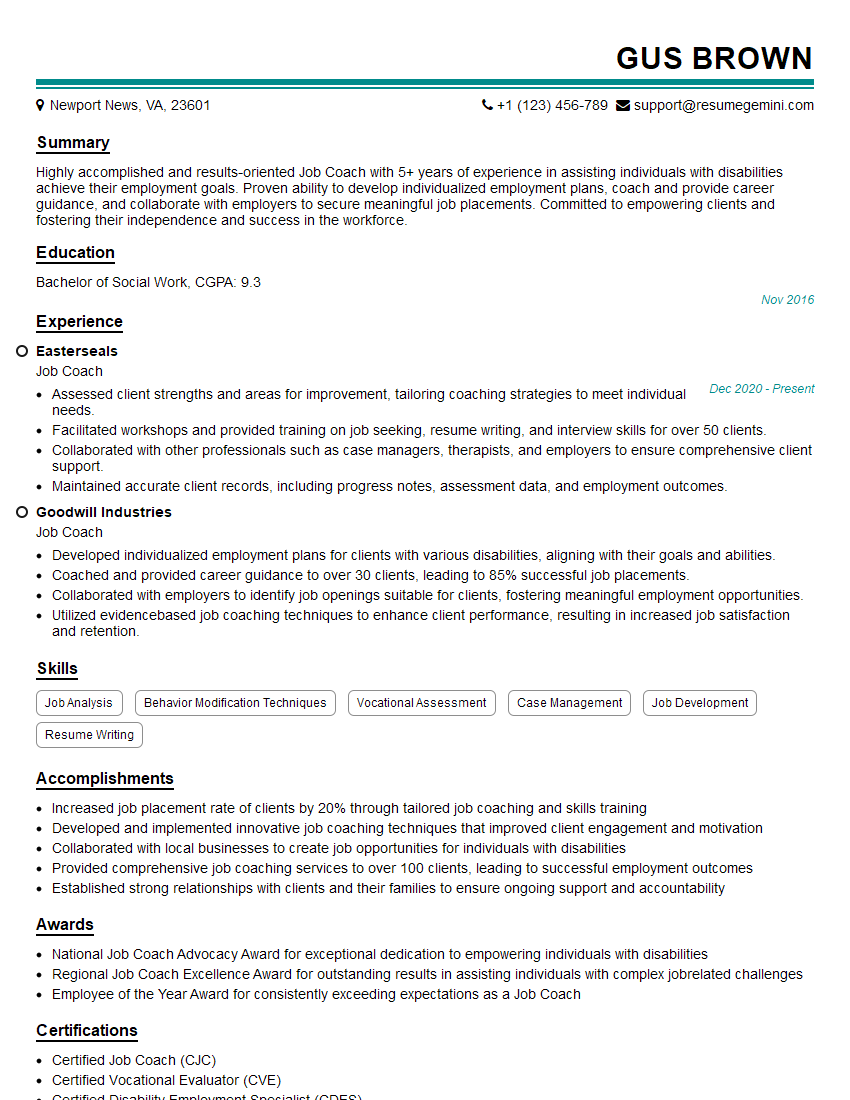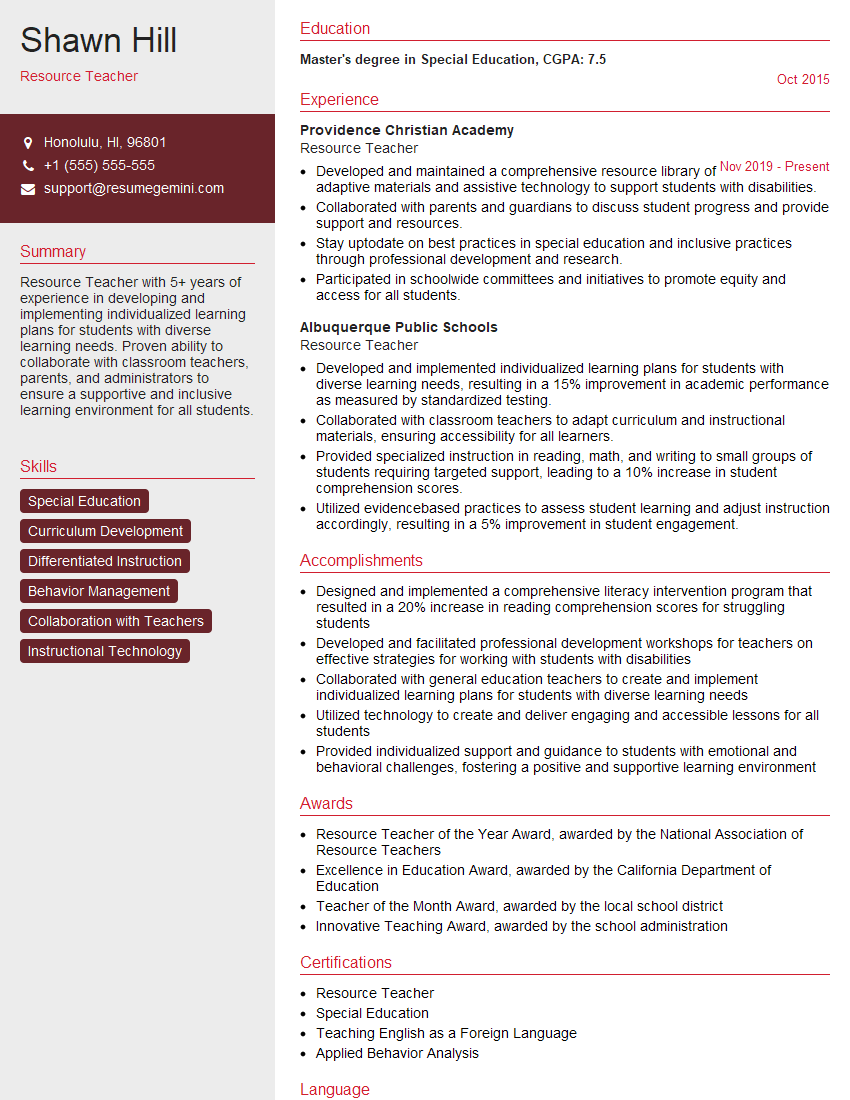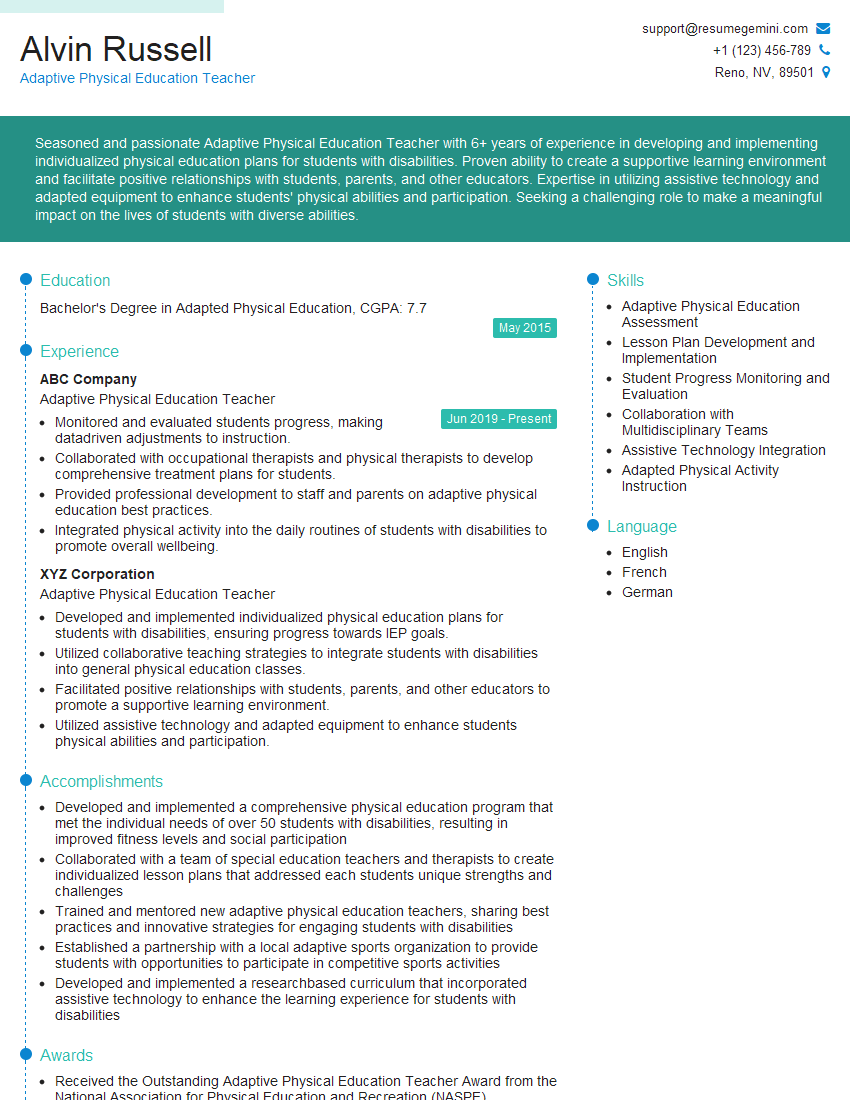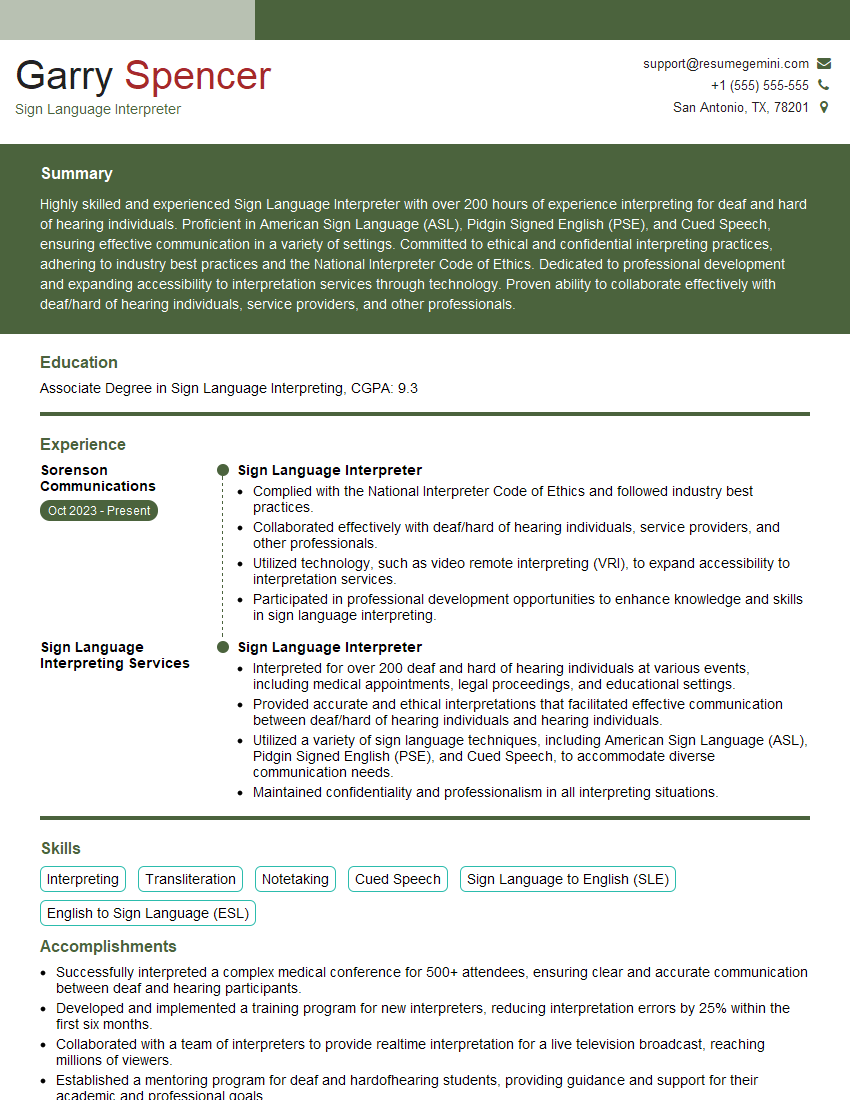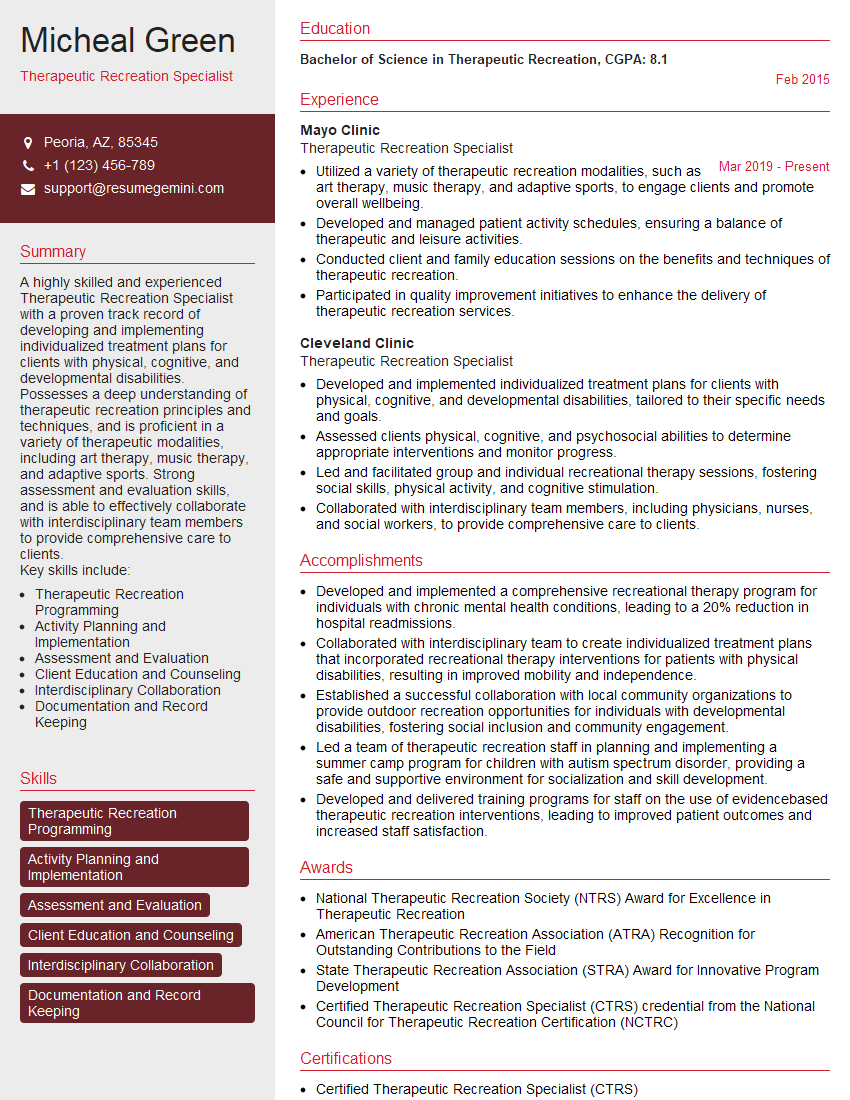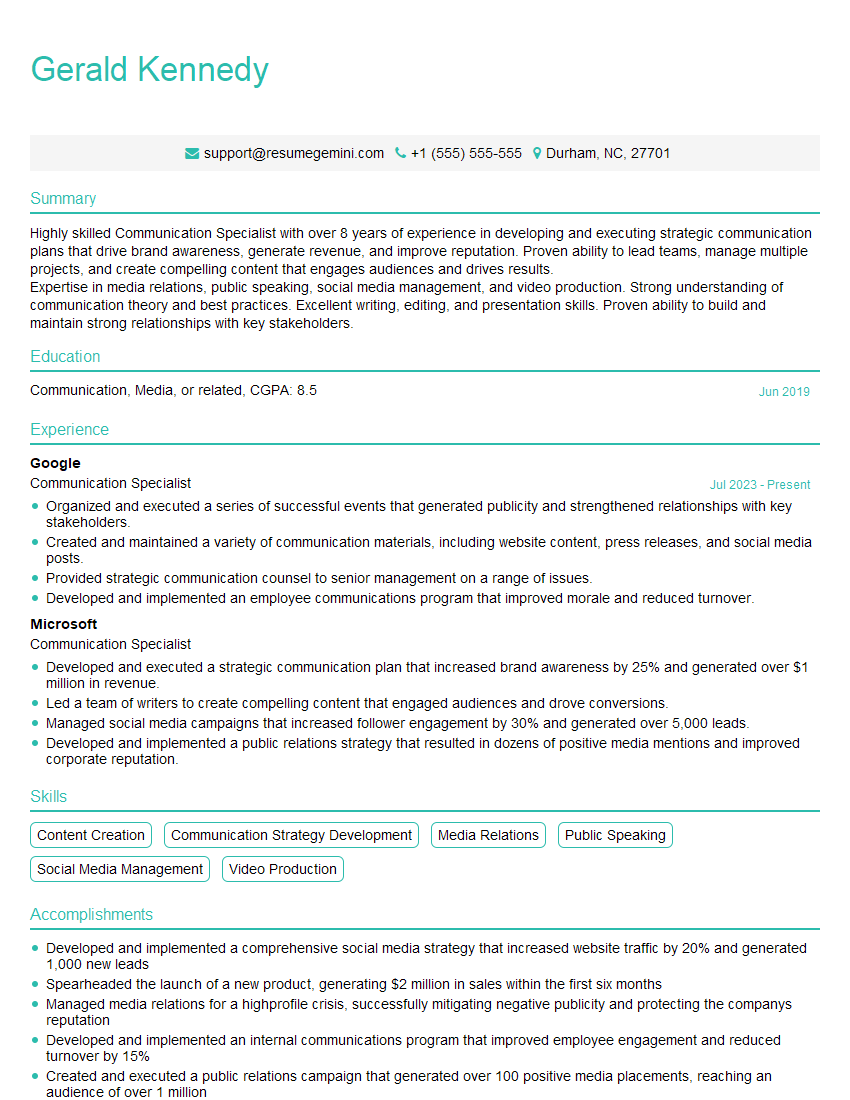Are you ready to stand out in your next interview? Understanding and preparing for Communication Strategies for Students with Mental Handicaps interview questions is a game-changer. In this blog, we’ve compiled key questions and expert advice to help you showcase your skills with confidence and precision. Let’s get started on your journey to acing the interview.
Questions Asked in Communication Strategies for Students with Mental Handicaps Interview
Q 1. Describe your experience using Augmentative and Alternative Communication (AAC) systems.
My experience with Augmentative and Alternative Communication (AAC) systems is extensive. I’ve worked with a wide range of AAC methods, from low-tech options like picture exchange systems (PECS) and communication boards to high-tech options such as speech-generating devices (SGDs) and apps. For example, I worked with a student who used PECS to initially communicate his needs, gradually transitioning to an SGD as his vocabulary and communication skills expanded. With SGDs, I’ve assisted students in customizing their devices with relevant vocabulary and images, ensuring they are intuitive and accessible. Successful implementation requires careful consideration of the student’s individual needs, cognitive abilities, and preferences. This includes regular assessments to determine the effectiveness of the AAC system and making necessary adjustments to ensure it remains a functional and supportive tool.
One crucial aspect is training both the student and their support network – parents, teachers, and peers – on how to effectively use and interpret the AAC system. This collaborative approach maximizes the system’s effectiveness and fosters a supportive communication environment.
Q 2. Explain different communication styles and their effectiveness with various disabilities.
Different communication styles have varying effectiveness with different disabilities. For instance, students with autism spectrum disorder (ASD) may benefit from clear, direct, and predictable communication styles. Visual supports, such as schedules or social stories, can significantly improve understanding and reduce anxiety. In contrast, students with intellectual disabilities may require simpler language, repetition, and visual aids. Students with ADHD may respond well to shorter, more focused interactions and strategies that encourage active listening.
- Direct Communication: Clear, concise instructions and feedback. Effective for most students, particularly those with ASD and intellectual disabilities, but needs adaptation for language level.
- Indirect Communication: Using hints or suggestions. Generally less effective for students with communication difficulties, but could be beneficial for encouraging self-expression in some cases.
- Visual Communication: Using pictures, symbols, and visual schedules. Crucial for students with ASD, intellectual disabilities, or visual learning preferences.
- Multi-Modal Communication: Combining various methods (verbal, visual, tactile). A very versatile approach that accommodates diverse learning styles and needs.
It’s crucial to remember that each student is unique, requiring a personalized approach. What works for one student may not work for another, even within the same disability group.
Q 3. How would you adapt communication strategies for a student with autism spectrum disorder?
Adapting communication strategies for a student with autism spectrum disorder (ASD) involves understanding their specific communication profile. Many students with ASD benefit from structured and predictable communication environments. This includes:
- Visual Supports: Using visual schedules, social stories, picture cards, or other visual aids to communicate routines, expectations, and transitions. This reduces uncertainty and anxiety.
- Clear and Concise Language: Avoiding ambiguity, figurative language, or sarcasm. Direct and literal communication is usually preferred.
- Active Listening and Patience: Providing ample time for the student to process information and respond. Avoid interrupting or pressuring them.
- Reinforcement and Positive Feedback: Rewarding attempts at communication, regardless of accuracy, to encourage engagement.
- Reducing Sensory Overload: Creating a calming and predictable environment that minimizes sensory distractions.
For example, using a visual schedule to show the steps involved in a classroom activity can significantly reduce anxiety and improve a student’s understanding of what’s expected.
Q 4. What are some common communication barriers faced by students with intellectual disabilities?
Students with intellectual disabilities often face various communication barriers, including:
- Limited Vocabulary and Expressive Language: Difficulty expressing their thoughts and needs effectively.
- Receptive Language Challenges: Difficulty understanding complex language or instructions.
- Difficulties with Pragmatics: Struggling with social aspects of communication, such as turn-taking, interpreting nonverbal cues, and understanding context.
- Cognitive Processing Deficits: Difficulties with processing information, memory, and attention.
- Social Communication Difficulties: Challenges initiating and maintaining conversations, understanding social cues, or engaging in reciprocal communication.
These barriers can lead to frustration, social isolation, and academic difficulties. Addressing these challenges requires a multi-faceted approach involving individualized communication strategies, and support from teachers, parents, and therapists.
Q 5. How do you assess a student’s communication skills?
Assessing a student’s communication skills involves a multifaceted approach combining formal and informal methods. This might involve:
- Formal Assessments: Standardized tests that evaluate receptive and expressive language, vocabulary, and pragmatic skills (e.g., CELF, CASL).
- Informal Assessments: Observations in natural settings, analyzing communication samples, and using checklists to track communication behaviors.
- Parent/Teacher Interviews: Gathering information about the student’s communication history and current strengths and weaknesses.
- Play-Based Assessment: Observing the student’s communication during play activities to evaluate their social interaction and communication skills.
The goal is to develop a comprehensive profile of the student’s strengths and weaknesses, to inform the development of an individualized communication plan.
Q 6. Explain your approach to developing an individualized communication plan.
Developing an individualized communication plan (ICP) is a collaborative process involving the student, parents, educators, and other relevant professionals. My approach involves:
- Assessment and Goal Setting: Conducting a thorough assessment of the student’s current communication skills and identifying specific goals.
- Strategy Selection: Choosing appropriate communication strategies and interventions based on the student’s needs and strengths.
- Implementation and Monitoring: Implementing the plan and regularly monitoring its effectiveness, making adjustments as needed.
- Collaboration and Communication: Maintaining open communication with all stakeholders, ensuring consistency across environments.
- Evaluation and Review: Regularly evaluating the plan’s progress and making necessary revisions to ensure the student’s needs are met.
The ICP should be dynamic and adaptable, regularly reviewed and revised as the student’s needs evolve. For example, if an SGD is used, regular check-ins might involve vocabulary updates and adjustments to the device’s settings based on the student’s progress.
Q 7. Describe your experience working with students who have limited verbal communication.
Working with students who have limited verbal communication requires a creative and flexible approach. I’ve used various strategies, including:
- AAC Systems: Implementing appropriate AAC systems, such as PECS, SGDs, or sign language, to facilitate communication.
- Environmental Modifications: Adapting the learning environment to make it more accessible and supportive of communication.
- Alternative Communication Modalities: Exploring different communication methods, such as drawing, writing, or using gestures.
- Focus on Functional Communication: Prioritizing communication skills that help the student meet their daily needs and participate in activities.
- Building Communication Partnerships: Collaborating closely with the student, their family, and other professionals to foster a supportive communication environment.
For example, I worked with a non-speaking student who used a combination of gestures and an SGD to express his needs and participate in class discussions. Patience, creativity, and a focus on the student’s individual strengths are essential in these situations.
Q 8. How do you incorporate assistive technology into communication strategies?
Incorporating assistive technology (AT) is crucial for enhancing communication in students with mental handicaps. AT bridges the gap between a student’s cognitive abilities and their communication needs. This could involve a range of tools, tailored to the individual’s specific challenges.
- Augmentative and Alternative Communication (AAC) devices: These can range from simple picture exchange systems (PECS) to sophisticated speech-generating devices (SGDs) that allow students to select words or phrases to create sentences. For instance, a student with limited verbal skills might use a PECS board to request a drink by pointing to the relevant picture. An SGD could allow a student with more complex language needs to construct complete sentences.
- Communication software: Software with features like text-to-speech, voice recognition, or word prediction can significantly improve writing and verbal communication. Imagine a student who struggles with spelling; a word prediction program can assist them in constructing written responses.
- Adaptive keyboards and input devices: These address physical limitations impacting typing. A student with fine motor challenges might benefit from a larger keyboard or an alternative input device like a trackball or eye-gaze system.
Choosing the right AT requires careful assessment of the student’s communication strengths and weaknesses, considering their cognitive abilities, physical capabilities, and learning style. Regular monitoring and adjustments are essential to ensure the technology remains effective and meets the student’s evolving needs.
Q 9. How would you handle a situation where a student becomes frustrated during communication?
Frustration during communication is common, particularly for students with mental handicaps who may struggle to express themselves effectively. My approach focuses on understanding the source of the frustration and implementing strategies to calm and support the student.
- Identify the trigger: Is the frustration due to a misunderstanding, difficulty expressing a need, overwhelming sensory input, or fatigue? Observing the student’s nonverbal cues is essential.
- Provide a calming environment: Reducing distractions and creating a safe, supportive space is crucial. This might involve moving to a quieter area, taking a short break, or offering sensory regulation tools.
- Use alternative communication methods: If verbal communication is proving difficult, offer alternative options, such as visual aids, gestures, or AAC devices. Perhaps a visual schedule or a simple ‘yes/no’ board will help.
- Model appropriate communication: Demonstrating calm and patient communication helps the student learn effective strategies for managing their frustration. For example, calmly acknowledging their feelings (‘I see you’re frustrated’) can de-escalate the situation.
- Positive reinforcement: Rewarding attempts at communication, regardless of the outcome, encourages future attempts. Even a simple nod or a positive verbal affirmation can be effective.
It’s crucial to document these events to better understand patterns and refine strategies. This documentation informs the overall communication plan.
Q 10. Describe your familiarity with Applied Behavior Analysis (ABA) principles in communication therapy.
Applied Behavior Analysis (ABA) is a highly effective framework for teaching communication skills. It’s based on the principles of learning and behavior change, focusing on observable behaviors and environmental factors.
- Discrete Trial Training (DTT): A structured approach where communication skills are taught through a series of carefully planned trials with clear instructions, prompts, and reinforcement. For example, I might repeatedly present a picture card and then praise and reward the student for verbally identifying the object in the picture.
- Functional Communication Training (FCT): Addresses challenging behaviors by teaching the student a more appropriate way to communicate their needs. For instance, a student who exhibits aggression to obtain attention might be taught to verbally ask for attention instead.
- Verbal Behavior (VB): Focuses on the function of language, breaking down communication into smaller units (mands, tacts, intraverbals, etc.) to teach specific verbal operants. This involves teaching the student to request items (mands), label things (tacts), and respond to questions (intraverbals).
ABA’s systematic approach, data-driven methodology, and focus on positive reinforcement make it an invaluable tool in communication therapy for students with mental handicaps. Ethical considerations and parent/guardian consent are of paramount importance in applying ABA therapy.
Q 11. What are some evidence-based communication strategies you utilize?
Evidence-based communication strategies are essential for maximizing impact. My practice incorporates several such approaches:
- Picture Exchange Communication System (PECS): A highly effective visual communication system, particularly for non-verbal students. It teaches students to initiate communication by exchanging pictures to express their wants and needs.
- Social Stories™: These are personalized narratives that help students understand social situations and expectations, which are then used to enhance communication skills in those social contexts. For instance, a story could help a student understand how to ask a peer for help.
- Augmentative and Alternative Communication (AAC): As discussed earlier, various AAC methods cater to diverse needs, offering pathways for students to communicate using symbols, pictures, or technology.
- Milieu Teaching: A naturalistic approach that focuses on teaching communication skills within the student’s daily environment, making learning more engaging and relevant.
The selection of strategies is always personalized, considering the student’s unique communication profile, cognitive abilities, and learning style. Data collected through regular assessments and observations guide strategy selection and adjustments.
Q 12. How do you collaborate with parents and other professionals to support a student’s communication development?
Collaboration is paramount to successful communication development. I actively involve parents and other professionals through:
- Regular meetings and communication: Sharing progress reports, challenges, and strategies ensures everyone is on the same page. I actively encourage parent participation in therapy sessions where appropriate.
- Shared goal setting: Working collaboratively to establish realistic and achievable goals ensures everyone works towards a common objective. Parent input and feedback are invaluable in this process.
- Consistent strategies across settings: I coordinate with parents and other professionals to ensure consistent application of strategies at home, school, and other relevant environments. This reduces confusion and maximizes the impact of interventions.
- Open communication channels: Creating an environment where everyone feels comfortable sharing concerns and providing feedback fosters a supportive collaboration.
This collaborative approach ensures a holistic and effective communication support system for the student. It also provides valuable insights into the student’s behaviour in different settings.
Q 13. Explain how you monitor the effectiveness of communication interventions.
Monitoring effectiveness is crucial for adapting and refining interventions. I use a variety of methods:
- Data collection: Tracking the frequency, accuracy, and independence of communication behaviors through systematic observation and data recording allows me to chart progress and identify areas requiring adjustments.
- Functional Behavior Assessments (FBAs): For students with challenging behaviors, FBAs help identify the function of those behaviors, informing strategies to replace them with more appropriate communication.
- Progress reports: Regular progress reports document the student’s communication development, highlighting successes, challenges, and modifications to the intervention plan.
- Parent/teacher feedback: Gathering feedback from parents, teachers, and other professionals provides valuable insights into the student’s communication progress across various settings.
This ongoing monitoring allows for flexible adjustments to the intervention plan, ensuring its continued effectiveness and relevance to the student’s needs.
Q 14. How do you address communication differences within inclusive classrooms?
Addressing communication differences in inclusive classrooms requires a proactive and multifaceted approach.
- Universal Design for Learning (UDL): Applying UDL principles creates a flexible learning environment that accommodates diverse communication needs. This involves providing multiple means of representation, action & expression, and engagement.
- Assistive technology integration: Making AT readily available and accessible for students with communication challenges ensures they can participate fully in classroom activities.
- Peer support and collaboration: Encouraging peer interaction and collaboration can help build social skills and communication confidence. Peer buddies can offer support and act as communication facilitators.
- Teacher training and support: Providing teachers with the necessary training and support to understand and address diverse communication needs empowers them to create an inclusive and effective learning environment.
- Differentiated instruction: Modifying teaching strategies and materials to meet individual student needs ensures that everyone can access and understand information.
Creating an inclusive environment where students feel valued and respected for their unique communication styles requires a commitment to understanding individual needs and providing appropriate support. The emphasis is on creating opportunities for meaningful participation and communication.
Q 15. What strategies do you employ to promote social communication skills?
Promoting social communication skills in students with mental handicaps requires a multifaceted approach focusing on building foundational skills and then gradually applying them in increasingly complex social situations. We start with basic communication elements like eye contact, turn-taking in conversations, and understanding nonverbal cues. This is achieved through structured activities, role-playing, and social stories.
Structured Activities: We might use games like Simon Says or card matching to practice turn-taking and following instructions, improving receptive communication. For example, a simple game of ‘I Spy’ helps with descriptive language and turn-taking.
Role-Playing: We create scenarios mimicking real-life social interactions, such as ordering food at a restaurant or asking for help. Students rehearse the appropriate language and responses in a safe environment. This helps them to anticipate and practice navigating diverse social situations.
Social Stories: These are customized narratives describing a social situation, explaining expected behaviors, and illustrating positive outcomes. For instance, a social story could address how to initiate a conversation with a peer during recess.
We progressively move to more advanced skills, such as initiating conversations, expressing needs and wants appropriately, understanding others’ perspectives, and engaging in collaborative activities. Regular positive reinforcement and celebrating successes are crucial for building confidence and motivation.
Career Expert Tips:
- Ace those interviews! Prepare effectively by reviewing the Top 50 Most Common Interview Questions on ResumeGemini.
- Navigate your job search with confidence! Explore a wide range of Career Tips on ResumeGemini. Learn about common challenges and recommendations to overcome them.
- Craft the perfect resume! Master the Art of Resume Writing with ResumeGemini’s guide. Showcase your unique qualifications and achievements effectively.
- Don’t miss out on holiday savings! Build your dream resume with ResumeGemini’s ATS optimized templates.
Q 16. Describe your experience adapting communication strategies based on a student’s cultural background.
Adapting communication strategies based on a student’s cultural background is essential for effective and respectful instruction. Understanding cultural nuances in communication styles is vital. For example, some cultures emphasize indirect communication, while others prioritize directness. Nonverbal cues also differ significantly across cultures. Eye contact, personal space, and touch are all culturally influenced.
In my experience, I’ve worked with students from various backgrounds, and I’ve learned to tailor my approach. For instance, with a student from a culture valuing nonverbal communication, I might focus more on observing body language and adapting my communication accordingly. Conversely, with a student from a culture emphasizing directness, I’ll ensure my instructions are clear and concise. I always involve the family and community in understanding the student’s cultural context. I also consult cultural resources and collaborate with other professionals familiar with the student’s background to develop culturally sensitive communication strategies.
One example involved a student from a culture where interrupting is considered acceptable. Instead of directly correcting this behavior, I focused on teaching the student appropriate alternative ways to contribute to conversations and gain attention, integrating the cultural norms into the learning process. Understanding and respecting the student’s cultural background is key to building rapport and fostering a successful learning environment.
Q 17. What are some visual communication strategies you utilize?
Visual communication strategies are extremely effective for students with mental handicaps, as they often process information visually more readily than through auditory channels. These strategies leverage images, symbols, and other visual aids to support communication and comprehension.
Picture Exchange Communication System (PECS): This involves using pictures or symbols to represent words or phrases, which the student exchanges with a communication partner to convey messages.
Visual Schedules: These schedules use pictures to show the sequence of activities throughout the day, providing predictability and reducing anxiety. This allows students to understand the flow of their day and anticipate transitions.
Augmentative and Alternative Communication (AAC) devices: These can include tablets with communication apps or specialized communication boards with pictures and symbols. These tools are particularly useful for students who have difficulty with verbal communication.
Visual supports for instructions: Incorporating visual cues within lesson plans, such as diagrams, charts, or graphic organizers, helps students understand complex information.
For example, using a visual schedule can help a student transition from one activity to the next by displaying pictures of activities in order. Similarly, a PECS system can allow a non-verbal student to request a specific item or express their needs effectively.
Q 18. How do you differentiate instruction to meet the diverse communication needs of students?
Differentiating instruction to meet diverse communication needs involves a personalized approach tailored to each student’s unique strengths and challenges. This means understanding the student’s communication profile, identifying their preferred communication methods, and adapting instructional strategies accordingly.
For students with limited verbal skills, I would heavily incorporate visual aids, AAC devices, and alternative communication methods like sign language. For students with receptive language challenges, I would break down instructions into smaller, simpler steps, using clear and concise language, and providing visual supports. Students with expressive language difficulties might benefit from sentence starters, visual organizers, or assistive technology to support their communication. I would also regularly assess student progress and adjust my teaching strategies based on their responses and performance.
For instance, a student struggling with attention might require shorter instructional periods with frequent breaks, while a student with auditory processing challenges might need visual cues and written instructions along with verbal ones. Regular monitoring and flexible adjustments are crucial for effective differentiation.
Q 19. Describe your familiarity with various types of communication assessments.
I am familiar with a wide range of communication assessments, both formal and informal. Formal assessments include standardized tests that measure various aspects of communication skills, such as receptive and expressive language, articulation, and pragmatics. Examples include the CELF-5 (Clinical Evaluation of Language Fundamentals) or the PLS-5 (Preschool Language Scale). These assessments provide objective data about a student’s communication abilities.
Informal assessments are equally important and include observations of the student in natural settings, analysis of language samples, and functional communication assessments that focus on real-world communication tasks. These assessments provide more contextualized data that helps me to understand how the student communicates in their daily life.
The selection of assessment tools depends on the student’s age, developmental level, and specific communication needs. The data gathered from these assessments inform the development of individualized education programs (IEPs) and guide the design of targeted communication interventions.
Q 20. Explain your understanding of the impact of mental health on communication.
Mental health significantly impacts communication. Conditions such as anxiety, depression, and autism spectrum disorder can influence various aspects of communication, including verbal fluency, nonverbal communication, social interaction, and comprehension. Anxiety, for example, can lead to difficulty expressing oneself clearly, while depression might result in reduced verbal output and engagement in social interactions.
Students experiencing mental health challenges may exhibit difficulty with initiating and maintaining conversations, understanding social cues, regulating emotions during communication, or expressing their thoughts and feelings appropriately. They might also display difficulties with attention and focus, impacting their ability to process information and respond to communication effectively. Recognizing these communication challenges is crucial to provide appropriate support and intervention.
It’s essential to collaborate with mental health professionals and build a supportive environment where students feel safe expressing themselves. Interventions may involve both therapeutic approaches to address the underlying mental health condition and specific communication strategies to improve communication skills.
Q 21. How do you promote effective communication between students and teachers?
Promoting effective communication between students and teachers requires establishing a collaborative and respectful learning environment. Open communication channels are crucial. Teachers should create opportunities for students to express their needs and concerns, using various communication methods tailored to the students’ capabilities. Regular check-ins, informal discussions, and clear expectations are vital.
Strategies include the use of visual supports, such as communication boards or picture schedules; employing assistive technology; and encouraging nonverbal cues. Teachers also need to be skilled in active listening, providing constructive feedback, and understanding nonverbal communication. For instance, providing a student with a ‘feelings chart’ can facilitate expression of complex emotions.
Regular communication with parents/guardians is also essential, ensuring a consistent approach to supporting the student’s communication needs both at home and at school. This includes providing feedback to parents on the student’s progress and collaborating on strategies to enhance communication.
Q 22. What strategies do you use to build rapport and trust with students with communication challenges?
Building rapport and trust with students who have communication challenges is paramount. It’s about creating a safe and accepting environment where they feel comfortable expressing themselves, however they can. I begin by observing their preferred communication methods – whether it’s verbal, nonverbal, or augmentative communication systems (AAC). I then tailor my interactions to match their comfort level.
- Patience and Non-Judgmental Approach: I avoid interrupting or correcting them constantly, focusing instead on understanding their attempts at communication, even if they are fragmented or incomplete. I show genuine interest in what they’re trying to convey.
- Positive Reinforcement: I consistently offer positive feedback for any communicative effort, no matter how small. A simple smile, nod, or verbal affirmation like “Good job trying!” goes a long way.
- Building Shared Routines: Establishing predictable routines and visual schedules helps reduce anxiety and provides a sense of security, making communication easier. For example, a visual schedule showing the steps involved in a classroom activity can reduce frustration.
- Relationship-Building Activities: Engaging in non-threatening activities that promote interaction, such as shared reading, art projects, or games, can help foster a positive connection.
For example, with a student who uses AAC, I might start by simply pointing to pictures and asking simple questions, gradually increasing the complexity as their confidence grows. With a student who struggles with verbal communication, I might start with using visual aids, such as picture cards, to facilitate conversation.
Q 23. How do you address challenging behaviors related to communication difficulties?
Challenging behaviors often stem from unmet needs or communication frustration. My approach focuses on understanding the underlying cause of the behavior rather than simply suppressing it.
- Functional Behavior Assessment (FBA): I conduct a thorough FBA to identify the triggers, antecedents, and consequences of the challenging behavior. This helps determine the function of the behavior – is it seeking attention, escaping a task, or communicating a need?
- Positive Behavior Support (PBS): Once the function is understood, I develop a PBS plan that focuses on teaching alternative, more appropriate communication skills and providing positive reinforcement for desired behaviors. This might involve teaching the student to use specific signs, phrases, or an AAC device to express their needs.
- Environmental Modifications: I adapt the learning environment to minimize triggers and support communication. This could involve reducing distractions, providing visual supports, or creating a calming corner.
- Collaboration with Team: I collaborate closely with parents, therapists, and other professionals to ensure a consistent approach across all settings. This unified strategy is crucial for success.
For instance, if a student is exhibiting disruptive behaviors during a transition, the FBA might reveal that they are struggling with the change in activity. The PBS plan would then focus on teaching them how to signal their need for a break or assistance, while also providing visual cues for transitions.
Q 24. Describe your experience with nonverbal communication techniques.
Nonverbal communication is a crucial aspect of my work. I understand that many students with communication challenges rely heavily on nonverbal cues. My expertise includes recognizing and interpreting various nonverbal signals like facial expressions, body language, and vocalizations.
- Observational Skills: I’m skilled at observing subtle nonverbal cues such as fidgeting, eye contact, or changes in posture. These cues can provide valuable insights into a student’s emotional state and understanding.
- Utilizing Nonverbal Communication: I use nonverbal strategies such as gestures, facial expressions, and proximity to facilitate communication and build rapport. For example, I might use a calming touch or a reassuring smile to help a student who is feeling anxious.
- Augmentative and Alternative Communication (AAC): I’m proficient in using various AAC systems, including picture exchange systems (PECS), sign language, and technological aids, to support nonverbal communication. The selection of the most appropriate AAC system is based on individual student needs and capabilities.
For example, a student might struggle to articulate their frustration, but their clenched fists and furrowed brow could signal significant distress. Recognizing this nonverbal cue allows me to intervene and address the underlying issue before it escalates.
Q 25. How do you document a student’s communication progress?
Documenting a student’s communication progress is essential for tracking their development and informing future interventions. I employ a multi-faceted approach to documentation.
- Data Collection: I collect data on various aspects of communication, including frequency of communication attempts, accuracy of communication, use of AAC systems, and reduction in challenging behaviors. This data is often collected using observation checklists, anecdotal records, and frequency counts.
- Qualitative Data: In addition to quantitative data, I collect qualitative data to capture the nuances of communication progress. Anecdotal notes describe specific instances of communication, highlighting successes and challenges.
- Progress Reports: I regularly write progress reports that summarize the student’s communication development, highlighting their strengths and areas needing further support. These reports are shared with parents and relevant team members.
- Visual Representations: Graphs and charts visually represent the student’s progress over time, allowing for easy monitoring and identification of trends.
For example, I might use a graph to track a student’s increasing use of specific words or phrases over a set period, illustrating improvement in their expressive language skills.
Q 26. How do you ensure communication strategies are aligned with Individualized Education Programs (IEPs)?
Alignment with the Individualized Education Program (IEP) is crucial for effective communication intervention. The IEP serves as a roadmap, guiding my strategies and ensuring consistency across all settings.
- IEP Review and Participation: I actively participate in IEP meetings, providing input on the student’s communication needs and recommending appropriate strategies and goals.
- Goal Setting: I help develop measurable and achievable communication goals that are directly reflected in the IEP. These goals are regularly reviewed and adjusted based on the student’s progress.
- Strategy Implementation: I ensure that all communication strategies employed are consistent with the interventions outlined in the IEP. This ensures that all individuals working with the student are on the same page.
- Data-Driven Adjustments: I regularly analyze data to assess the effectiveness of the IEP’s communication strategies and make adjustments as needed to maximize the student’s progress.
For instance, if the IEP identifies a goal of increasing the student’s use of a specific AAC device, I would incorporate strategies such as modeling, positive reinforcement, and opportunities for practice to facilitate the student’s progress toward that goal.
Q 27. What professional development have you undertaken in communication strategies for students with mental handicaps?
I’ve undertaken extensive professional development to enhance my skills in communication strategies for students with mental handicaps. This includes:
- Specialized Training: I’ve completed training in Augmentative and Alternative Communication (AAC), including specific methods like PECS and the use of technological AAC devices.
- Positive Behavior Support (PBS) Certification: I’m certified in Positive Behavior Support, which has significantly improved my ability to address challenging behaviors in a proactive and positive manner.
- Workshops and Conferences: I regularly attend workshops and conferences focused on communication intervention strategies for students with disabilities. This keeps me abreast of the latest research and best practices.
- Continuing Education: I actively engage in ongoing professional development to stay current with evidence-based practices in the field. This may involve online courses, reading professional journals, and collaborating with other professionals.
This ongoing professional development ensures that I remain current in my field, employing the most effective and ethical strategies to support my students.
Q 28. Describe your understanding of the legal and ethical considerations in supporting students’ communication.
Supporting students’ communication involves a deep understanding of legal and ethical considerations. These considerations guide my practice and ensure that I act in the best interests of my students.
- Confidentiality: I strictly adhere to confidentiality guidelines, protecting student information and respecting their privacy. This includes secure storage of records and appropriate disclosure of information only to authorized individuals.
- Individualized Approach: I recognize that each student has unique needs and communication styles. My strategies are tailored to each individual, respecting their autonomy and preferences.
- Informed Consent: I always obtain informed consent from parents or guardians before implementing any intervention strategies. This ensures that they are fully aware of the approach and can participate in decision-making.
- Compliance with Laws and Regulations: I’m well-versed in relevant laws and regulations, such as the Individuals with Disabilities Education Act (IDEA), ensuring that all my practices are legally sound and ethically appropriate.
- Advocacy: I advocate for my students’ right to access appropriate communication support and resources, working collaboratively with parents and educational teams to remove barriers to effective communication.
For example, before implementing a new communication intervention, I ensure that I obtain written parental consent, explaining the rationale and potential benefits and risks in terms they can readily understand. This ensures that the process is both ethical and legally compliant.
Key Topics to Learn for Communication Strategies for Students with Mental Handicaps Interview
- Understanding Diverse Communication Needs: Explore the spectrum of communication styles and challenges faced by students with diverse mental health conditions and intellectual disabilities. Consider the impact of various diagnoses on communication.
- Adaptive Communication Techniques: Learn practical strategies for adapting your communication style to effectively engage students with varying needs. This includes techniques like visual aids, simplified language, and alternative communication methods (AAC).
- Building Rapport and Trust: Understand the importance of establishing positive relationships based on respect and empathy. Explore techniques for building trust and creating a safe communication environment.
- Active Listening and Nonverbal Communication: Master active listening skills and the interpretation of nonverbal cues, recognizing that these may differ significantly from neurotypical individuals.
- Effective Feedback and Instruction: Develop strategies for providing clear, concise, and positive feedback tailored to individual learning styles and needs. Learn how to modify instructional strategies for optimal comprehension.
- Collaboration with Support Staff: Understand the importance of collaboration with other professionals, such as special education teachers, therapists, and parents, to create a cohesive support system for the student.
- Addressing Challenging Behaviors: Learn strategies for de-escalating challenging behaviors and communicating effectively during crisis situations. Explore positive behavior support (PBS) methodologies.
- Assistive Technology and its Integration: Familiarize yourself with various assistive technologies that can aid communication, and understand how to effectively integrate them into the educational process.
- Legal and Ethical Considerations: Understand relevant legislation (e.g., IDEA) and ethical considerations related to confidentiality, privacy, and informed consent.
- Assessment and Evaluation of Communication Skills: Explore different methods for assessing communication progress and adapting strategies based on ongoing evaluation.
Next Steps
Mastering communication strategies for students with mental handicaps is crucial for building a rewarding and impactful career in education and related fields. Your expertise in this area will be highly sought after, opening doors to diverse and fulfilling opportunities. To significantly boost your job prospects, create an ATS-friendly resume that effectively highlights your skills and experience. ResumeGemini is a trusted resource that can help you build a professional and compelling resume that stands out. Examples of resumes tailored to Communication Strategies for Students with Mental Handicaps are available to guide you through the process.
Explore more articles
Users Rating of Our Blogs
Share Your Experience
We value your feedback! Please rate our content and share your thoughts (optional).
What Readers Say About Our Blog
Hi, I’m Jay, we have a few potential clients that are interested in your services, thought you might be a good fit. I’d love to talk about the details, when do you have time to talk?
Best,
Jay
Founder | CEO
